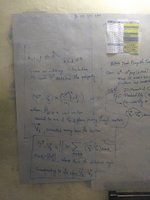Incenter of a tetrahedron
- Thread starter cgossman
- Start date
Hi all,
I'm having trouble finding a procedure for finding the incenter of a tetrahedron using primarily vectors or matricies. the points are A(0,1,-2) B(1,3,1) C(2,-1,0) and D(3,1,-1)
any formula, tip or hint would be appreciated!
Actually you are looking for the coordinates of the center of a sphere whose radius is the perpendicular distance to the planes. Here is how I would do thisd question. Maybe there exists a short-cut ...?
1. Determine the equations of the 4 planes. For instance
p(ABC):−5x−2y+3z+8=0
3 more following, preferable in the same form.
2. Re-write these equations so that the normal vector of the plane is a unit vector, but in such a way that the constant summand is negative. (In Germany this is called the Hesse normal form of the equation of the plane) For instance:
p(ABC):−381(+5x+2y−3z−8)=0
3 more following, preferable in the same form.
4. I(xi,yi,zi) and r denote the incenter and the perpendicular distance of I to all 4 planes respectively. Use the normal form of #2 to calculate the distance of I to every plane. For instance:
−381(+5xi+2yi−3zi−8)=r
3 more following, preferable in the same form.
5. Solve this system of simultaneous equations for (xi,yi,zi,r)
I will provide my proof to this method if you want to, but here it is :
Consider a tetrahedron with vertices labelled 1,2,3,4. Let the sides opposite to each vertex be labelled the same number as that vertex.

Note that if two vectors are (anti)parallel one of them is just a scalar multiple of the other (non-null vectors). This is what you must exploit.
If you pick one vertex and do this, you will get a parametric family of solutions (each coordinate will be of the form at+b where t is a parameter)
Then pick a different vertex and perform the same procedure, but instead plug in these parametric coordinates to find the value of your parameter.
Depending upon the situation, use a suitable form (the first or second expression, both mean the same thing).
This is extremely long though.
EDIT : The summation is badly expressed, sorry about that. What I mean is,
If I label my vertices 1,2,3,4 and i let k=2
Then, due to my labeling, cyclically choose two out of p1, p3 and p4 and find the cross product. I.e. the LHS is equal to
t(p1×p4 + p4×p3 + p3×p1). Always stick to one cycle.
Also the inradius is given by √(|t|).
Consider a tetrahedron with vertices labelled 1,2,3,4. Let the sides opposite to each vertex be labelled the same number as that vertex.

Note that if two vectors are (anti)parallel one of them is just a scalar multiple of the other (non-null vectors). This is what you must exploit.
If you pick one vertex and do this, you will get a parametric family of solutions (each coordinate will be of the form at+b where t is a parameter)
Then pick a different vertex and perform the same procedure, but instead plug in these parametric coordinates to find the value of your parameter.
Depending upon the situation, use a suitable form (the first or second expression, both mean the same thing).
This is extremely long though.
EDIT : The summation is badly expressed, sorry about that. What I mean is,
If I label my vertices 1,2,3,4 and i let k=2
Then, due to my labeling, cyclically choose two out of p1, p3 and p4 and find the cross product. I.e. the LHS is equal to
t(p1×p4 + p4×p3 + p3×p1). Always stick to one cycle.
Also the inradius is given by √(|t|).
Last edited:
